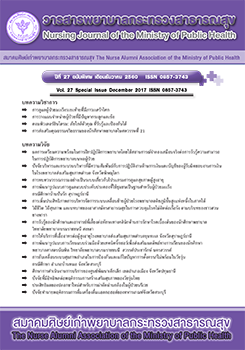Lifestyle, Lifestyle Related to Health and Village Health Volunteer’s Roles in Non-Communicable Diseases Control in Rubber Planters Context
Main Article Content
Abstract
This qualitative study aimed to describe rubber planters’ lifestyle, lifestyle related to health and the Village Health Volunteers (VHV) roles in Non-Communicable Diseases (NCD) control in Ban Phai Yai, Wang Nokand, Wang Thong, Phitsanulok. Forty rubber planters and VHVs were included as participants. Semi-structure interview guidelines were used as the research tools. Data were collected by in-depth interviews with a tape recorder, non-participant observations, taking field notes and sound recordings. Content analysis was used to analyze the data.
The results showed that: 1) rubber planters’ lifestyle associated with “life timeline” was different from general norm. Lifestyle related to health consisted of consuming energy drinks coffee smoking, and alcohol consumption. They thought that “working was exercise”. They spent time after their morning work for relaxation. Their economic constraints made them stressed, so they participated in merit-making activities and talking with their family or friends to relieve their tension. 2) VHVs expected roles for NCD control included provide appropriate guidelines for problem solving; possess knowledge for appropriate modifications such as checking blood sugar after meals, self-care guidelines, and taking medicine appropriate with the context and time; and participate with community leaders to set activities for health promoting consistent with the community context.
Article Details
บทความและรายงานวิจัยในวารสารพยาบาลกระทรวงสาธารณสุข เป็นความคิดเห็นของ ผู้เขียน มิใช่ของคณะผู้จัดทำ และมิใช่ความรับผิดชอบของสมาคมศิษย์เก่าพยาบาลกระทรวงสาธารณสุข ซึ่งสามารถนำไปอ้างอิงได้
References
2. Beuro of Non Communicable Disease. Annual report 2015. Bangkok: Ministry of Public Health; 2016.
3. Kitreerawutiwong N. Chronic illness care in primary care. Journal of Public Health Nursing 2016;30(1):113-26.(in Thai).
4. Sittisart V. The development of strategies to improve village health volunteers’ performance in the control of non-communicable diseases (NCD): a case study in the lower northern region [Master thesis]. Phitsanulok: Naresuan University. 2013.(inThai).
5. Department of Health Service Support Ministry of Public Health. Strategic Plan Department of Health Service Support Ministry of Public Health from 2009-2011. [Internet]. 2011. [cited 2017 Feb 6]. Available from: http://www.hss.moph.go.th/file_upload/p2506-1.pdf
6. Data of Non Communicable Disease. Annual report 2015. Phitsanulok: Ban Phai Yai Health Promotion Hospital; 2015. (in Thai).
7. Pattaraporn S. Working Environment and health status of the rubber farmer in Bantat subdistrict, Maung district, Udon Thanni Province [Master thesis]. Khonkaen: Khonkaen University : 2009. (in Thai).
8. Pravate W. Create values for community health, future of the mation and humanity is at human values and strengthen community. Bangkok: QTP Limited. 2009. (in Thai).
9. Chai P. Science and Art of Qualitative Research. 7thed. Bangkok: Amarin Printing & Publishing. 2016. (in Thai).
10. Yupaporn J, Chavapornpan C, Wanpen S. Health preventive behaviors among rubber plantation Workers 2007;16(3):390-99.(in Thai).
11. Sudaporn W, Uraiwan I. health risk assesment from rubber farming activities in Nongsang district, Udonthani province. Journal of Public Health Research 2012;5(1):13-20. (in Thai).
12. American Diabetes Association: Checking your blood glucose [Internet]. 2016 [cited 2017 Feb 6]. Available from:http://www.diabetes.org/living-with-diabetes/treatment-and-care/blood-glucose-control/checking-our-blood -glucose.html.
13. Punyapat C, Tum Boonrod. Factors affecting self-care among rubber farmers. The Public Health Journal of Burapha University 2013;7(1):42-49.(in Thai).

